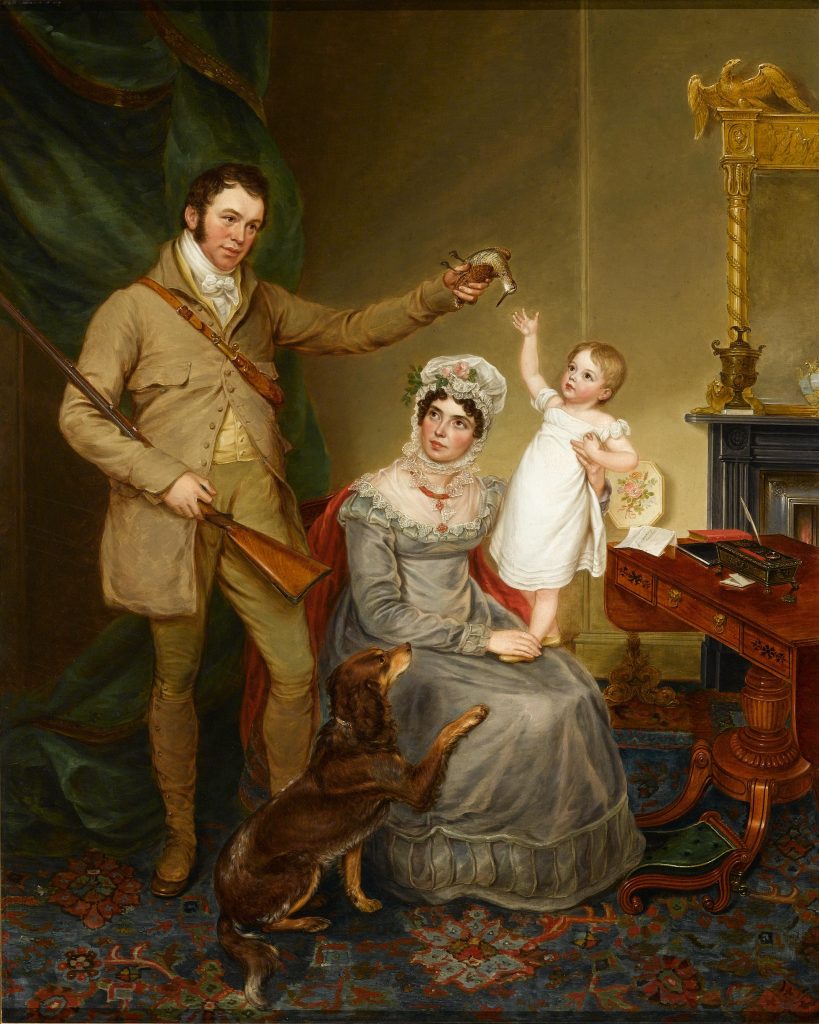Case Study 11: The Palmer Family by James Leakey c.1822
Starting with a note of the names of the adult sitters, the researcher uses biographical evidence: census returns and a will, to establish the identity of the child sitter and a date of execution for the portrait. These sources provide a cultural context in which the sitters’ lives can be more fully understood.
The Palmer family
“A re-examination of the inscription on the back of this painting has established it was written by John Kirkham Fox in 1919 and tells us it depicts “My Grandfather & Grandmother, Samuel and Mary Palmer nee Hinde.” By tracing Fox’s family history (1) it has been possible to establish the details and provenance of this family group.
The Rev. John Kirkham Fox was born at Topsham in 1849. He was the son of Charles Fox, surgeon and his wife Eleanor (nee Palmer). It is her parents, Samuel and Mary Palmer, and her sister Joanna who are the subject of Leakey’s painting.
Samuel and Mary Palmer lived in the 1820s at Newington, Surrey. By the time of the 1841 census we find them settled at Dulwich Common. Here they enjoyed considerable comfort and were supported a decade later by a cook, a footman, a coachman and a housemaid. In his will, proved in 1850, Samuel Palmer described himself as “Esquire” (2). It is clear from this source that he had financial interests in the business (unspecified) of his brother James, while another brother, William Henry Palmer, was a wine merchant in Fenchurch Street, London.
Palmer’s will is of particular interest because it includes a brief description of this painting as one of the three family portraits that Palmer was adamant should remain in the family. He set out in some detail how they, together with a silver salver and vase, should eventually pass to his eldest son and his heirs, but in default to his eldest daughter’s family or his elder brother. In the immediate future his widow was to have the use of them. The paintings are described as “my three family pictures (that is to say) one of my father and mother one of my self and wife and our daughter Joanna and of my self alone”.
The salver and vase were gifts from the parishioners of St. Mary Newington “as an acknowledgment for services they were pleased to consider has been rendered by me to that Parish.” This sounds rather like a departing gift, perhaps to a long-serving churchwarden, from a grateful parish prior to the move to Dulwich.
The will identifies the child in Leakey’s portrait as Joanna. Joanna Veale (3) Palmer, daughter of Samuel and Mary, was born on 7 February 1819 and christened on 7 July 1819 at St. Mary’s Newington. If Joanna was about three years old in the portrait, then the painting was produced c.1822.
Samuel Palmer’s interest in shooting is reflected in his will. To his eldest son, John Hinde Palmer, he left “all my Fowling Pieces and Rifles.”
In the 1851 census the newly widowed Mary Palmer is listed living at Dulwich Common. Her occupation is described as an annuitant. She was then sixty-seven, indicating she was born c.1784. The census tells us her birthplace was Hertford, but her christening there has not been traced. By the time of the suggested date of the painting, c.1822, she would have been about thirty-eight years old.”
Author: Stephen Price
Footnotes
- The principal sources were the nationwide census returns for 1851-1901, now available electronically, and the IGI.
- TNA PCC PROB11/2110 Will of Samuel Palmer of Dulwich, Surrey, 18 March 1850
- In his will (footnote 2 above) Samuel Palmer refers to his Veale ancestors.

